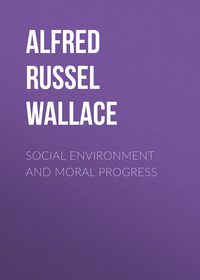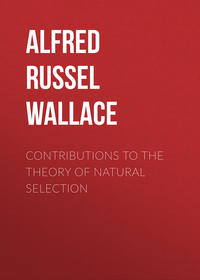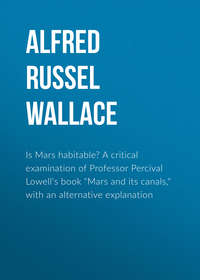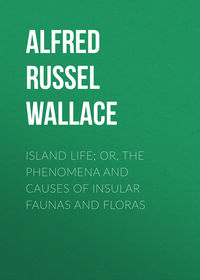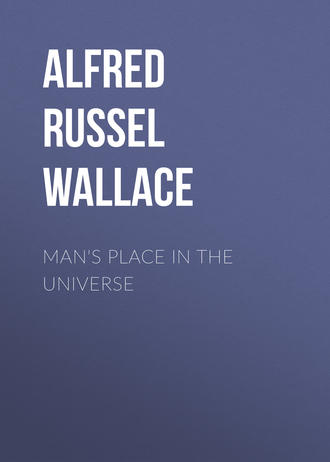 полная версия
полная версияMan's Place in the Universe
This remarkable fact of the enormous remoteness of the majority of the brighter stars is equally effective as an argument against the loss of light by dark stars or cosmic dust, because, if the light is not appreciably diminished for stars which have less than the fiftieth of a second of parallax, it cannot greatly interfere with our estimates of the limits of our universe.
Both Mr. E.W. Maunder of the Greenwich Observatory and Professor W.W. Turner of Oxford lay great stress on these dark bodies, and the former quotes Sir Robert Ball as saying, 'the dark stars are incomparably more numerous than those that we can see … and to attempt to number the stars of our universe by those whose transitory brightness we can perceive would be like estimating the number of horseshoes in England by those which are red-hot.' But the proportion of dark stars (or nebulæ) to bright ones cannot be determined a priori, since it must depend upon the causes that heat the stars, and how frequently those causes come into action as compared with the life of a bright star. We do know, both from the stability of the light of the stars during the historic period and much more precisely by the enormous epochs during which our sun has supported life upon this earth—yet which must have been 'incomparably' less than its whole existence as a light-giver—that the life of most stars must be counted by hundreds or perhaps by thousands of millions of years. But we have no knowledge whatever of the rate at which true stars are born. The so-called 'new stars' which occasionally appear evidently belong to a different category. They blaze out suddenly and almost as suddenly fade away into obscurity or total invisibility. But the true stars probably go through their stages of origin, growth, maturity, and decay, with extreme slowness, so that it is not as yet possible for us to determine by observation when they are born or when they die. In this respect they correspond to species in the organic world. They would probably first be known to us as stars or minute nebulæ: at the extreme limit of telescopic vision or of photographic sensitiveness, and the growth of their luminosity might be so gradual as to require hundreds, perhaps thousands of years to be distinctly recognisable. Hence the argument derived from the fact that we have never witnessed the birth of a true permanent star, and that, therefore, such occurrences are very rare, is valueless. New stars may arise every year or every day without our recognising them; and if this is the case, the reservoir of dark bodies, whether in the form of large masses or of clouds of cosmic dust, so far from being incomparably greater than the whole of the visible stars and nebulæ, may quite possibly be only equal to it, or at most a few times greater; and in that case, considering the enormous distances that separate the stars (or star-systems) from each other, they would have no appreciable effect in shutting out from our view any considerable proportion of the luminous bodies constituting our stellar universe. It follows, that Professor Newcomb's argument as to the very small total light given by the stars has not been even weakened by any of the facts or arguments adduced against it.
Mr. W.H.S. Monck, in a letter to Knowledge (May 1903), puts the case very strongly so as to support my view. He says:—'The highest estimate that I have seen of the total light of the full moon is 1/300000 of that of the sun. Suppose that the dark bodies were a hundred and fifty thousand times as numerous as the bright ones. Then the whole sky ought to be as bright as the illuminated portion of the moon. Every one knows that this is not so. But it is said that the stars, though infinite, may only extend to infinity in particular directions, e.g. in that of the Galaxy. Be it so. Where, in the very brightest portion of the Galaxy, will we find a part equal in angular magnitude to the moon which affords us the same quantity of light? In the very brightest spot, the light probably does not amount to one hundredth part that of the full moon.' It follows that, even if dark stars were fifteen million times as numerous as the bright ones, Professor Newcomb's argument would still apply against an infinite universe of stars of the same average density as the portion we see.
Telescopic Evidence as to the Limits of the Star SystemThroughout the earlier portion of the nineteenth century every increase of power and of light-giving qualities of telescopes added so greatly to the number of the stars which became visible, that it was generally assumed that this increase would go on indefinitely, and that the stars were really infinite in number and could not be exhausted. But of late years it has been found that the increase in the number of stars visible in the larger telescopes was not so great as might be expected, while in many parts of the heavens a longer exposure of the photographic plate adds comparatively little to the number of stars obtained by a shorter exposure with the same instrument.
Mr. J.E. Gore's testimony on this point is very clear. He says:—'Those who do not give the subject sufficient consideration, seem to think that the number of the stars is practically infinite, or at least, that the number is so great that it cannot be estimated. But this idea is totally incorrect, and due to complete ignorance of telescopic revelations. It is certainly true that, to a certain extent, the larger the telescope used in the examination of the heavens, the more the number of the stars seems to increase; but we now know that there is a limit to this increase of telescopic vision. And the evidence clearly shows that we are rapidly approaching this limit. Although the number of stars visible in the Pleiades rapidly increases at first with increase in the size of the telescope used, and although photography has still further increased the number of stars in this remarkable cluster, it has recently been found that an increased length of exposure—beyond three hours—adds very few stars to the number visible on the photograph taken at the Paris Observatory in 1885, on which over two thousand stars can be counted. Even with this great number on so small an area of the heavens, comparatively large vacant places are visible between the stars, and a glance at the original photograph is sufficient to show that there would be ample room for many times the number actually visible. I find that if the whole heavens were as rich in stars as the Pleiades, there would be only thirty-three millions in both hemispheres.'
Again, referring to the fact that Celoria, with a telescope showing stars down to the eleventh magnitude, could see almost exactly the same number of stars near the north pole of the Galaxy as Sir William Herschel found with his much larger and more powerful telescope, he remarks: 'Their absence, therefore, seems certain proof that very faint stars do not exist in that direction, and that here, at least, the sidereal universe is limited in extent.'
Sir John Herschel notes the same phenomena, stating that even in the Milky Way there are found 'spaces absolutely dark and completely void of any star, even of the smallest telescopic magnitude'; while in other parts 'extremely minute stars, though never altogether wanting, occur in numbers so moderate as to lead us irresistibly to the conclusion that in these regions we see fairly through the starry stratum, since it is impossible otherwise (supposing their light not intercepted) that the numbers of the smaller magnitudes should not go on continually increasing ad infinitum. In such cases, moreover, the ground of the heavens, as seen between the stars, is for the most part perfectly dark, which again would not be the case if innumerable multitudes of stars, too minute to be individually discernible, existed beyond.' And again he sums up as follows:—'Throughout by far the larger portion of the extent of the Milky Way in both hemispheres, the general blackness of the ground of the heavens on which its stars are projected, and the absence of that innumerable multitude and excessive crowding of the smallest visible magnitudes, and of glare produced by the aggregate light of multitudes too small to affect the eye singly, which the contrary supposition would appear to necessitate, must, we think, be considered unequivocal indications that its dimensions in directions where these conditions obtain, are not only not infinite, but that the space-penetrating power of our telescopes suffices fairly to pierce through and beyond it.'2
This expression of opinion by the astronomer who, probably beyond any now living, was the most competent authority on this question, to which he devoted a long life of observation and study extending over the whole heavens, cannot be lightly set aside by the opinions or conjectures of those who seem to assume that we must believe in an infinity of stars if the contrary cannot be absolutely proved. But as not a particle of evidence can be adduced to prove infinity, and as all the facts and indications point, as here shown, in a directly opposite direction, we must, if we are to trust to evidence at all in this matter, arrive at the conclusion that the universe of stars is limited in extent.
Dr. Isaac Roberts gives similar evidence as regards the use of photographic plates. He writes:—'Eleven years ago photographs of the Great Nebula in Andromeda were taken with the 20-inch reflector, and exposures of the plates during intervals up to four hours; and upon some of them were depicted stars to the faintness of 17th to 18th magnitude, and nebulosity to an equal degree of faintness. The films of the plates obtainable in those days were less sensitive than those which have been available during the past five years, and during this period photographs of the nebula with exposures up to four hours have been taken with the 20-inch reflector. No extensions of the nebulosity, however, nor increase in the number of the stars can be seen on the later rapid plates than were depicted upon the earlier slower ones, though the star-images and the nebulosity have greater density on the later plates.'
Exactly similar facts are recorded in the cases of the Great Nebula in Orion, and the group of the Pleiades. In the case of the Milky Way in Cygnus photographs have been taken with the same instrument, but with exposures varying from one hour to two hours and a half, but no fainter stars could be found on one than on the other; and this fact has been confirmed by similar photographs of other areas in the sky.
The Law of Diminishing Numbers of StarsWe will now consider another kind of evidence equally weighty with the two already adduced. This is what may be termed the law of diminishing numbers beyond a certain magnitude, as observed by larger and larger telescopes.
For some years past star-magnitudes have been determined very accurately by means of careful photometric comparisons. Down to the sixth magnitude stars are visible to the naked eye, and are hence termed lucid stars. All fainter stars are telescopic, and continuing the magnitudes in a series in which the difference in luminosity between each successive magnitude is equal, the seventeenth magnitude is reached and indicates the range of visibility in the largest telescopes now in existence. By the scale now used a star of any magnitude gives nearly two and a half times as much light as one of the next lower magnitude, and for accurate comparison the apparent brightness of each star is given to the tenth of a magnitude which can easily be observed. Of course, owing to differences in the colour of stars, these determinations cannot be made with perfect accuracy, but no important error is due to this cause. According to this scale a sixth magnitude star gives about one-hundredth part of the light of an average first magnitude star. Sirius is so exceptionally bright that it gives nine times as much light as a standard or average first magnitude star.
Now it is found that from the first to the sixth magnitude the stars increase in number at the rate of about three and a half times those of the preceding magnitudes. The total number of stars down to the sixth magnitude is given by Professor Newcomb as 7647. For higher magnitudes the numbers are so great that precision and uniformity are more difficult of attainment; yet there is a wonderful continuance of the same law of increase down to the tenth magnitude, which is estimated to include 2,311,000 stars, thus conforming very nearly with the ratio of 3.5 as determined by the lucid stars.
But when we pass beyond the tenth magnitude to those vast numbers of faint stars only to be seen in the best or the largest telescopes, there appears to be a sudden change in the ratio of increased numbers per magnitude. The numbers of these stars are so great that it is impossible to count the whole as with the higher magnitude stars, but numerous counts have been made by many astronomers in small measured areas in different parts of the heavens, so that a fair average has been obtained, and it is possible to make a near approximation to the total number visible down to the seventeenth magnitude. The estimate of these by astronomers who have made a special study of this subject is, that the total number of visible stars does not exceed one hundred millions.3
But if we take the number of stars down to the ninth magnitude, which are known with considerable accuracy, and find the numbers in each succeeding magnitude down to the seventeenth, according to the same ratio of increase which has been found to correspond very nearly in the case of the higher magnitudes, Mr. J.E. Gore finds that the total number should be about 1400 millions. Of course neither of these estimates makes any pretence to exact accuracy, but they are founded on all the facts at present available, and are generally accepted by astronomers as being the nearest approach that can be made to the true numbers. The discrepancy is, however, so enormous that probably no careful observer of the heavens with very large telescopes doubts that there is a very real and very rapid diminution in the numbers of the fainter as compared with the brighter stars.
There is, however, yet one more indication of the decreasing numbers of the faint telescopic stars, which is almost conclusive on this question, and, so far as I am aware, has not yet been used in this relation. I will therefore briefly state it.
The Light Ratio as Indicating the Number of Faint StarsProfessor Newcomb points out a remarkable result depending on the fact that, while the average light of successively lower magnitudes diminishes in a ratio of 2.5, their numbers increase at nearly a ratio of 3.5. From this it follows that, so long as this law of increase continues, the total of starlight goes on increasing by about forty per cent. for each successive magnitude, and he gives the following table to illustrate it:—
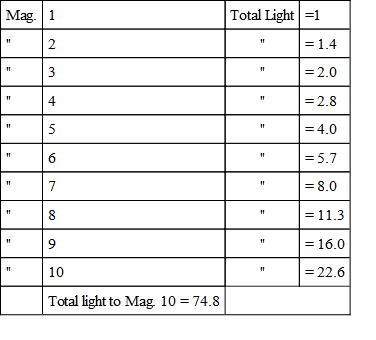
Thus the total amount of the light given by all stars down to the tenth magnitude is seventy-four times as great as that from the few first magnitude stars. We also see that the light given by the stars of any magnitude is twice as much as that of the stars two magnitudes higher in the scale, so that we can easily calculate what additional light we ought to receive from each additional magnitude if they continue to increase in numbers below the tenth as they do above that magnitude. Now it has been calculated as the result of careful observations, that the total light given by stars down to nine and a half magnitude is one-eightieth of full moonlight, though some make it much more. But if we continue the table of light-ratios from this low starting-point down to magnitude seventeen and a half, we shall find, if the numbers of the stars go on increasing at the same rate as before, that the light of all combined should be at least seven times as great as moonlight; whereas the photometric measurements make it actually about one-twentieth. And as the calculation from light-ratios only includes stars just visible in the largest telescopes, and does not include all those proved to exist by photography, we have in this case a demonstration that the numbers of the stars below the tenth and down to the seventeenth magnitude diminish rapidly.
We must remember that the minuter telescopic stars preponderate enormously in and near the Milky Way. At a distance from it they diminish rapidly, till near its poles they are almost entirely absent. This is shown by the fact (already referred to at p. 146) that Professor Celoria of Milan, with a telescope of less than three inches aperture, counted almost as many stars in that region as did Herschel with his eighteen-inch reflector. But if the stellar universe extends without limit we can hardly suppose it to do so in one plane only; hence the absence of the minuter stars and of diffused milky light over the larger part of the heavens is now held to prove that the myriads of very minute stars in the Milky Way really belong to it, and not to the depths of space far beyond.
It seems to me that here we have a fairly direct proof that the stars of our universe are really limited in number.
There are thus four distinct lines of argument all pointing with more or less force to the conclusion that the stellar universe we see around us, so far from being infinite, is strictly limited in extent and of a definite form and constitution. They may be briefly summarised as follows:—
(1) Professor Newcomb shows that, if the stars were infinite in number, and if those we see were approximately a fair sample of the whole, and further, if there were not sufficient dark bodies to shut out almost the whole of their light, then we should receive from them an amount of light theoretically greater than that of sunlight. I have shown, at some length, that neither of these causes of loss of light will account for the enormous disproportion between the theoretical and the actual light received from the stars; and therefore Professor Newcomb's argument must be held to be a valid one against the infinite extent of our universe. Of course, this does not imply that there may not be any number of other universes in space, but as we know absolutely nothing of them—even whether they are material or non-material—all speculation as to their existence is worse than useless.
(2) The next argument depends on the fact that all over the heavens, even in the Milky Way itself, there are areas of considerable extent, besides rifts, lanes, and circular patches, where stars are either quite absent or very faint and few in number. In many of these areas the largest telescopes show no more stars than those of moderate size, while the few stars seen are projected on an intensely dark background. Sir William Herschel, Humboldt, Sir John Herschel, R.A. Proctor, and many living astronomers hold that, in these dark areas, rifts, and patches, we see completely through our stellar universe into the starless depths of space beyond.
(3) Then we have the remarkable fact that the steady increase in the number of stars, down to the ninth or tenth magnitudes, following one constant ratio either gradually or suddenly changes, so that the total number from the tenth down to the seventeenth magnitudes is only about one-tenth of what it would have been had the same ratio of increase continued. The conclusion to be drawn from this fact clearly is, that these faint stars are becoming more and more thinly scattered in space, while the dark background on which they are usually seen shows that, except in the region of the Milky Way, there are not multitudes of still smaller invisible stars beyond them.
(4) The last indication of a limited stellar universe—the estimate of numbers by the light-ratio of each successive magnitude—powerfully supports the three preceding arguments.
The four distinct classes of evidence now adduced must be held to constitute, as nearly as the circumstances permit, a satisfactory proof that the stellar universe, of which our solar system forms a part, has definite limits; and that a full knowledge of its form, structure, and extent, is not beyond the possibility of attainment by the astronomers of the future.
CHAPTER VIII
OUR RELATION TO THE MILKY WAYWe now approach what may be termed the very heart of the subject of our inquiry, the determination of how we are actually situated within this vast but finite universe, and how that position is likely to affect our globe as being the theatre of the development of life up to its highest forms.
We begin with our relation to the Milky Way (which we have fully described in our fourth chapter), because it is by far the most important feature in the whole heavens. Sir John Herschel termed it 'the ground-plane of the sidereal system'; and the more it is studied the more we become convinced that the whole of the stellar universe—stars, clusters of stars, and nebulæ—are in some way connected with it, and are probably dependent on it or controlled by it. Not only does it contain a greater number of stars of the higher magnitudes than any other part of the heavens of equal extent, but it also comprises a great preponderance of star-clusters, and a great extent of diffused nebulous matter, besides the innumerable myriads of minute stars which produce its characteristic cloud-like appearance. It is also the region of those strange outbursts forming new stars; while gaseous stars of enormous bulk—some probably a thousand or even ten thousand times that of our sun, and of intense heat and brilliancy—are more abundant there than in any other part of the heavens. It is now almost certain that these enormous stars and the myriads of minute stars just visible with the largest telescopes, are actually intermingled, and together constitute its essential features; in which case the fainter stars are really small and cannot be far apart, forming, as it were, the first aggregations of the nebulous substratum, and perhaps supplying the fuel which keeps up the intense brilliancy of the giant suns. If this is so, then the Galaxy must be the theatre of operation of vast forces, and of continuous combinations of matter, which escape our notice owing to its enormous distance from us. Among its millions of minute telescopic stars, hundreds or thousands may appear or disappear yearly without being perceived by us, till the photographic charts are completed and can be minutely scrutinised at short intervals. As undoubted changes have occurred in many of the larger nebulæ during the last fifty years, we may anticipate that analogous changes will soon be noted in the stars and the nebulous masses of the Milky Way. Dr. Isaac Roberts has even observed changes in nebulæ after such a short interval as eight years.
The Milky Way a Great CircleNotwithstanding all its irregularities, its divisions, and its diverging branches, astronomers are generally agreed that the Milky Way forms a great circle in the heavens. Sir John Herschel, whose knowledge of it was unrivalled, stated that its course 'conforms, as nearly as the indefiniteness of its boundary will allow it to be fixed, to that of a great circle'; and he gives the Right Ascension and Declination of the points where it crosses the equinoctial, in figures which define those points as being exactly opposite each other. He also defines its northern and southern poles by other figures, so as to show that they are the poles of a great circle. And after referring to Struve's view that it was not a great circle, he says, 'I retain my own opinion.' Professor Newcomb says that its position 'is nearly always near a great circle of the sphere'; and again he says: 'that we are in the galactic plane itself seems to be shown in two ways: (1) the equality in the counts of stars on the two sides of this plane all the way to its poles; and (2) the fact that the central line of the Galaxy is a great circle, which it would not be if we viewed it from one side of its central plane' (The Stars, p. 317). Miss Clerke, in her History of Astronomy, speaks of 'our situation in the galactic plane' as one of the undisputed facts of astronomy; while Sir Norman Lockyer, in a lecture delivered in 1899, said, 'the middle line of the Milky Way is really not distinguishable from a great circle,' and again in the same lecture—'but the recent work, chiefly of Gould in Argentina, has shown that it practically is a great circle.'4
About this fact, then, there can be no dispute. A great circle is a circle dividing the celestial sphere into two equal portions, as seen from the earth, and therefore the plane of this circle must pass through the earth. Of course the whole thing is on such a vast scale, the Milky Way varying from ten to thirty degrees wide, that the plane of its circular course cannot be determined with minute accuracy. But this is of little importance. When carefully laid down on a chart, as in that of Mr. Sidney Waters (see end of volume), we can see that its central line does follow a very even circular course, conforming 'as nearly as may be' to a great circle. We are therefore certainly well within the space that would be enclosed if its northern and southern margins were connected together across the vast intervening abyss, and in all probability not far from the central plane of that enclosed space.


